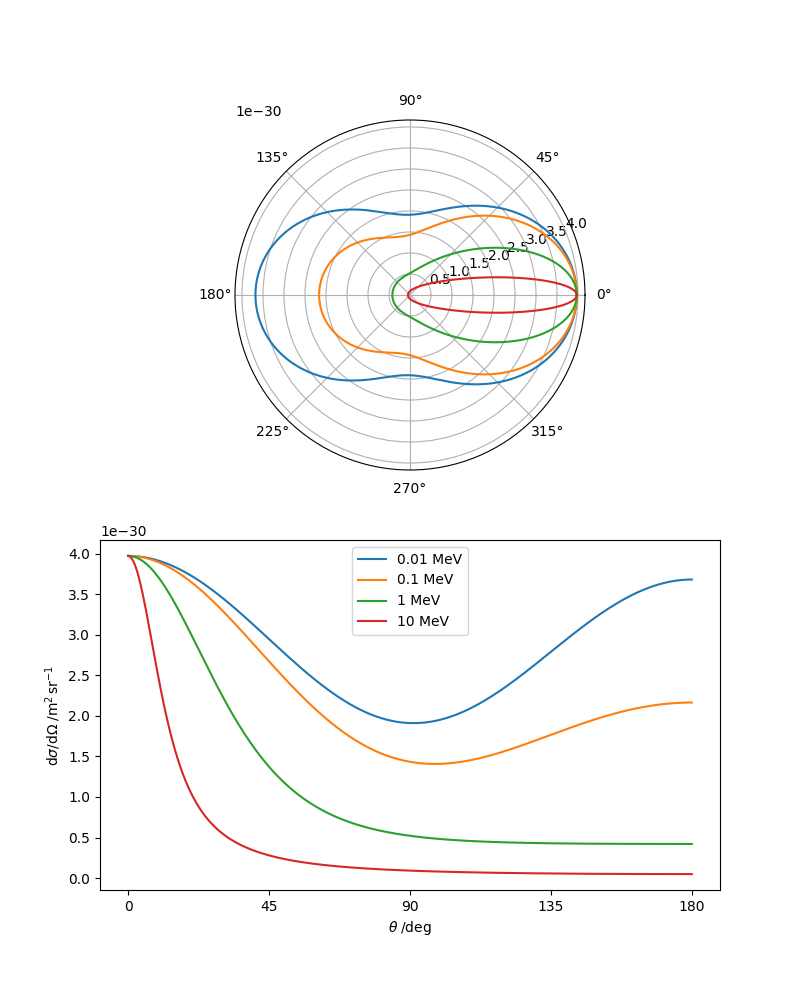The Klein–Nishina formula
Posted on 18 December 2021
The Klein–Nishina formula gives the differential cross section for the scattering of photons off an electron. At low energies, light scatters elastically (Thomson scattering); at higher energies (for example, gamma radiation), inelastic Compton scattering occurs. In terms of the incoming and outgoing photon wavelengths, $\lambda$ and $\lambda'$:
$$ \frac{\mathrm{d}\sigma}{\mathrm{d}\Omega} = \frac{\hbar^2\alpha^2}{2m_e^2c^2}\left(\frac{\lambda}{\lambda'}\right)^2\left[\frac{\lambda}{\lambda'} + \frac{\lambda'}{\lambda} - \sin^2\theta\right], $$
where $\mathrm{d}\sigma$ is the cross section for scattering into solid angle $\mathrm{d}\Omega$ at an angle $\theta$ from the incoming direction. The scattered wavelength is given by the Compton scattering formula:
$$ \Delta\lambda = \lambda' - \lambda = \frac{h}{m_ec}(1-\cos\theta). $$
The Python code below plots the following figure for the angular dependence of the differential cross section at different incoming photon energies. At low energies, forward and back-scattering are equally likely (blue line: 10 keV); at high energies, forward scattering dominates and most of the photon's energy is transferred to the electron (red line: 10 MeV).

import numpy as np
import matplotlib.pyplot as plt
from scipy.constants import e, h, hbar, alpha, c, m_e
DPI = 100
# A bunch of constants factored into a single variable.
f = (hbar * alpha / m_e / c)**2 / 2
# A grid of scattering angles in rad.
theta = np.arange(0, 2*np.pi, 0.01)
n = len(theta)
def plot_diff_xsec(E):
"""Plot the differential cross section for incoming photon energy, E."""
# Incoming photon frequency (s-1) and wavelength (m).
nu = E * 1.e6 * e / h
lam = c / nu
# Scattered photon wavelength (m).
lamp = lam + h / m_e / c * (1 - np.cos(theta))
P = lam / lamp
# Differential cross section given by the Klein-Nishina formula.
dsigma_dOmega = f * P**2 * (P + 1/P - np.sin(theta)**2)
# Plot the polar and Cartesian plots.
ax1.plot(theta, dsigma_dOmega, label=str(E) + r' MeV')
# Because of the symmetry, we only really need angles 0 -> 180 deg.
ax2.plot(np.degrees(theta[:n//2]), dsigma_dOmega[:n//2],
label=str(E) + r' MeV')
# A Matplotlib figure with a polar Axes above a Cartesian one.
fig = plt.figure(figsize=(800/DPI, 1000/DPI))
ax1 = fig.add_subplot(211, projection='polar')
ax2 = fig.add_subplot(212)
# Our grid of photon energies (in MeV).
Egrid = 0.01, 0.1, 1, 10
for E in Egrid:
plot_diff_xsec(E)
ax2.set_xlabel(r'$\theta\;/\mathrm{deg}$')
ax2.set_ylabel(r'$\mathrm{d}\sigma/\mathrm{d}\Omega\;/\mathrm{m^2\,sr^{-1}}$')
# Set the Cartesian x-axis ticks to sensible values (in degrees).
ax2.set_xticks([0, 45, 90, 135, 180])
plt.legend()
plt.show()